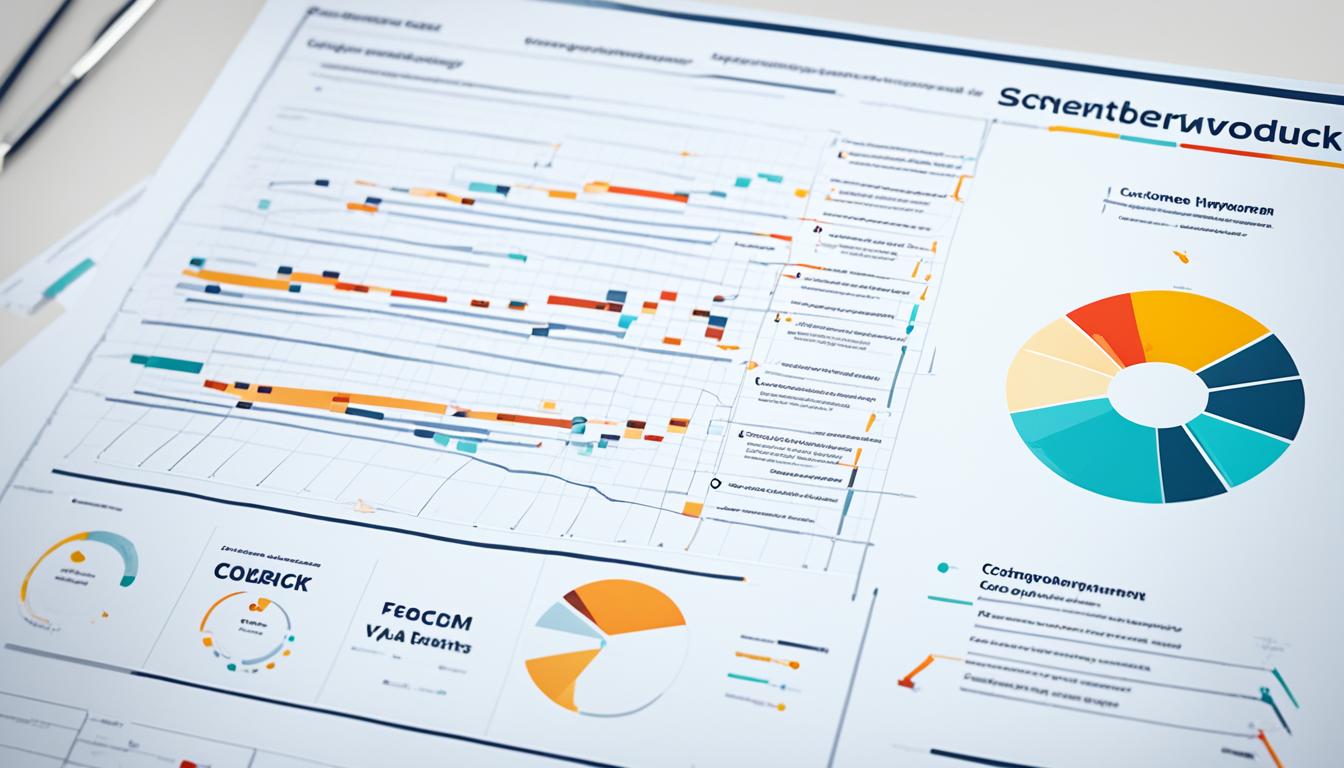Have you ever thought that negative reviews could help your business grow? In today’s digital world, customer feedback is like gold, especially in e-commerce where we don’t often talk face-to-face1. Let’s see how making the most of negative feedback can lead to big changes and boost your brand’s image.
Customer feedback, especially from negative reviews, is a direct way to talk to your customers1. It’s like having a chat with each customer, figuring out what they need, and seeing where we might not be meeting their expectations. By using this feedback, we can keep getting better and make our customers happier.
Did you know a single negative review can stop up to 92% of new customers from coming to you2? That’s a huge number, but it’s also a chance. By fixing these issues, we can not only keep more customers but also show we care about making them happy. This way, we build trust, increase loyalty, and stand out from others.
Key Takeaways
- Negative reviews provide valuable insights for improvement
- Customer feedback is crucial in e-commerce for understanding needs
- Addressing negative reviews can prevent significant customer loss
- Proactive response to feedback builds trust and loyalty
- Leveraging customer insights drives continuous improvement
- Feedback analysis tools can help manage large volumes of data
Understanding the Value of Negative Customer Feedback
Negative customer feedback is a treasure for businesses wanting to get better. It shows what customers struggle with, helping companies focus on key issues. In fact, 72% of consumers say negative reviews add depth and insight to products3.
Customer sentiment in negative feedback shows a business’s weak spots. By looking into this feedback, companies can find out about product problems, service gaps, or communication issues. This info helps make better decisions and fix customer problems.
Seeing negative feedback as a chance to learn can greatly improve products, service, and how people see the brand. Remember, 66% of customers want businesses to know their needs, and 68% have switched brands because of bad experiences4.
Even negative feedback is key for getting better. Companies that listen to and act on customer feedback often see more loyal customers and higher satisfaction. Fixing complaints quickly can turn unhappy customers into fans, helping the business grow4.
“Negative feedback is a compass pointing towards areas of improvement. Embrace it, learn from it, and use it to elevate your business.”
To make the most of negative feedback, businesses should use good ways to collect it. This could be through surveys, emails, or usability tests. By sorting and analyzing this feedback well, companies can find clear steps to improve534.
Collecting and Organizing Customer Feedback Effectively
In today’s world, customer feedback is like gold. We use different ways to collect it. Surveys, social media, and interviews are key methods6. They help us know our customers better and make our products or services better.

Having a strong feedback management system is key. It lets us sort feedback, spot trends, and focus on important issues. This way, we can make useful actions from the feedback.
Social media is a big source of customer feedback6. In fact, 59% of people think more of a brand if it answers complaints on social media7. So, it’s vital to keep an eye on and talk to customers online.
Customer interviews give us deep insights into what users think6. These talks can show things we might miss in big surveys. Focus groups are also great for getting many different views quickly and without spending a lot6.
“Listening to customers is not just good practice; it’s essential for business growth. 60% of consumers would buy more if businesses treated them better.”
To get the most from feedback, we should listen across all channels. This way, we catch a lot of what customers feel in many places. Remember, 63% of consumers say companies need to listen better8. By using these smart ways to collect and organize feedback, we show our customers we really care about what they say.
Analyzing Negative Reviews for Actionable Insights
In today’s world, what customers say can greatly affect a business. It’s key to look closely at negative reviews to find ways to get better. By using advanced methods like sentiment analysis and text analytics, we can find important lessons in what customers say.

Root cause analysis lets us find the real reasons behind why customers are unhappy. We look for common themes and patterns to see what needs quick action. This helps us make smart choices and create plans to fix customer issues.
Studies show that 77% of customers like brands more when they ask for and use their feedback9. This shows how important it is to really listen to what customers say. Also, up to 86% of buyers are willing to pay more for a better experience, showing how feedback can help a business grow10.
- Collect feedback from various channels (surveys, social media, reviews)
- Categorize and combine data for comprehensive analysis
- Use AI-powered tools for efficient data processing
- Implement changes based on insights
- Track improvements over time
By focusing on what customers want and using AI to analyze feedback, businesses can turn negative feedback into useful lessons. This not only makes customers happier but also keeps them coming back. Remember, 89% of people check reviews online before buying, so it’s crucial for brands to listen and act on what customers say1110.
Utilizing Customer Feedback for Improvement

Putting the customer first is crucial for making better products and services. By listening to what customers say, companies can find new ideas for growth. Those who focus on customer feedback keep more customers than those who don’t12.
Improving customer experience means listening well. Using surveys, reviews, and social media helps companies understand what customers want13. This way, companies can make their products better, add new features, and meet customer needs.
Changing things based on what customers say helps match services with what customers expect12. For instance, a bakery cut down on wait times by changing how they staffed the store, thanks to customer feedback12. This shows how listening to customers can make real changes.
Talking to customers in a personal way and thanking them builds loyalty and trust12. It’s a cheap way to learn more about the market and make things better for customers14. By showing customers they matter, companies get more engaged customers, more sales, and good reviews14.
In today’s market, using customer feedback is key to staying on top. By focusing on what customers say, companies show they care about making customers happy. This leads to success over the long run.
Implementing Changes Based on Customer Insights
We believe in the power of customer-driven initiatives to change our business. By using customer insights, we can make a strong change management strategy. This keeps us ahead. Our method includes working together across different teams for ongoing improvement.
We start by focusing on feedback that could make a big difference and is doable. This means making detailed plans, getting the right resources, and setting deadlines. Customer insights help us build stronger relationships, increase loyalty, and do better in business15.

Our strategy for making changes quickly lets us test and improve fast. We use A/B testing to see what customers like about digital experiences. This has led to big wins, like an 8.2% increase in click-through rates for some companies16.
“Customer feedback is the compass that guides our product improvement journey.”
Changing little by little based on customer feedback works best. To make this easier, we’ve set up strong feedback loops. These make sure customer insights get into our product development cycle17.
| Feedback Source | Implementation Strategy | Expected Outcome |
|---|---|---|
| Online Surveys | Quarterly Product Updates | Enhanced User Experience |
| Social Media | Real-time Response System | Improved Customer Satisfaction |
| Customer Support | Monthly Feature Refinement | Reduced Pain Points |
Working with different teams helps us improve our products better. This teamwork uses various skills and insights. It makes sure our changes meet customer needs and work well operationally17.
Measuring the Impact of Feedback-Driven Improvements
We use key performance indicators (KPIs) to see how our feedback-driven improvements work. Net Promoter Score (NPS), Customer Satisfaction (CSAT), and Customer Effort Score (CES) show us what customers think and feel18. These metrics give us important info on how our changes help the customer.
Data analytics is key in seeing if our improvements work. We look at feedback response rates to see how engaged customers are19. By analyzing feedback trends, we find common themes and areas to improve, which helps us make better product choices19.
We use data visualization like charts and dashboards to show our progress18. These tools make it easy to see and share feedback data. We compare before and after feedback periods to see how customer satisfaction and loyalty change19.
“Measuring the impact of feedback-driven improvements is not just about numbers; it’s about understanding the story behind customer experiences and using that knowledge to drive meaningful change.”
We check how fast and well we make changes based on feedback. This helps us quickly solve customer issues19. We also look at customer retention to see how our feedback loop keeps customers coming back19.
Tools like SurveySensum, HubSpot CRM, or Google Analytics help us manage customer feedback better20. These tools collect insights from social media, email, and review sites, giving us a full picture of what customers like and dislike20.
| Metric | Purpose | Impact Measurement |
|---|---|---|
| Net Promoter Score (NPS) | Evaluate customer loyalty and advocacy | Brand loyalty and positive word-of-mouth referrals |
| Customer Satisfaction Score (CSAT) | Monitor satisfaction levels before and after changes | Improvements in customer experiences |
| Customer Effort Score (CES) | Measure ease of customer interactions | Reduction in customer effort and friction points |
| Feedback Response Rate | Track customer engagement in feedback process | Participation and involvement in improvement initiatives |
| Customer Retention Rate | Assess impact on customer loyalty | Long-term customer relationships and business growth |
By focusing on these metrics and refining our approach, we make sure our feedback-driven improvements really make a difference. This helps us see a good return on investment (ROI).
Communicating Changes to Customers and Stakeholders
We understand how crucial clear communication is for building trust with our brand. When we update things based on what customers say, it shows we listen and act. This builds a strong connection with them.
We use many ways to talk to our customers. Through emails, social media, and special website areas, we share the good changes. This way, we make sure everyone gets the message.
Research tells us that 66% of customers want companies to really get what they need and want21. By telling customers how we’ve used their feedback, we make them more engaged and loyal.
Inside our company, we keep everyone updated on how we’re using customer feedback. This helps us all focus on putting the customer first. Sharing updates on how we’re improving helps everyone see the big picture.
| Benefits of Effective Communication | Impact |
|---|---|
| Improved Efficiency | Higher productivity |
| Better Customer Satisfaction | Increased loyalty |
| Reduced Costs | Improved bottom line |
| Stakeholder Buy-in | Support for future initiatives |
Having a clear plan for talking to people helps lower stress and resistance among our team22. This, along with our focus on managing stakeholders, makes sure our changes are welcomed and last over time.
Conclusion
We’ve looked into how using customer feedback, even from negative reviews, can help businesses grow and improve. Customer insights are key, with 53% of shoppers checking reviews before buying23. By focusing on what customers want, companies can gain a big edge over the competition.
It’s important to have a good system for handling feedback. While most companies gather customer opinions, only a few use it to get better and tell customers what they’re doing about it24. This shows a big chance for businesses to shine by really listening and acting on what customers say. Companies like Amazon and Starbucks use different ways to get feedback to spark new ideas and keep customers coming back24.
Improving based on customer feedback is more than just solving problems. It’s about creating new ideas and building strong relationships. When companies really listen to customers and fix issues, they often get more loyal customers23. By always looking at feedback, spotting trends, and making changes, businesses can keep getting better. Remember, today, what customers say is more powerful than ads, making them your best brand supporters23.
FAQ
Why is negative customer feedback important for businesses?
How can businesses effectively collect and organize customer feedback?
What techniques can be used to analyze negative reviews for actionable insights?
How can businesses utilize customer feedback for improvement?
What is the process for implementing changes based on customer insights?
How can businesses measure the impact of feedback-driven improvements?
Why is it important to communicate changes to customers and stakeholders?
Source Links
- Customer Feedback: Turning Reviews into Actionable Insights Utilizing customer feedback for continuous improvement. – https://www.linkedin.com/pulse/customer-feedback-turning-reviews-actionable-insights-homame-soussi-fopxc
- Boost Your Business: 5 Proven Ways to Get Rave Reviews – https://www.signpost.com/blog/boost-your-business-get-rave-reviews/
- Customer feedback: the importance of both positive and negative reviews – https://churnzero.com/blog/customer-feedback-the-importance-of-both-positive-and-negative-reviews/
- The Importance of Negative Customer Feedback – Conversion Rate… – https://qeryz.com/blog/importance-negative-customer-feedback/
- Customer Feedback: Why It’s Important + 7 Ways to Collect It – Help Scout – https://www.helpscout.com/blog/customer-feedback/
- Customer feedback: 7 strategies to collect and leverage it – https://www.zendesk.com/blog/customer-feedback-hear-voice-customer/
- How To Collect Customer Feedback – 6 Methods – https://monkeylearn.com/blog/customer-feedback-methods/
- What Customer Feedback To Collect – And When – https://www.qualtrics.com/experience-management/customer/collecting-customer-feedback/
- Customer Feedback Analysis: How To Analyze & Act on Feedback – https://rapidr.io/blog/customer-feedback-analysis/
- How To Do Insighful Customer Review Analysis | Idiomatic – https://idiomatic.com/blog/customer-review-analysis/
- Actionable Insights for CX Improvement with Customer Feedback Analytics – https://chattermill.com/blog/customer-feedback-analytics
- How to Use Customer Feedback to Improve Service – https://www.process.st/how-to/use-customer-feedback-to-improve-service/
- Utilizing customer feedback for continuous improvement in acquisition strategies – https://aicontentfy.com/en/blog/utilizing-customer-feedback-for-continuous-improvement-in-acquisition-strategies
- Smart Ways to Use Customer Feedback – https://www.business.com/articles/how-to-use-customer-feedback/
- Customer Insights: How to Use Feedback to Improve Experience – https://www.dashclicks.com/blog/how-to-use-customer-insights
- Customer Insights: How to Use Feedback to Improve Experience – https://blog.hubspot.com/service/how-to-use-customer-feedback
- How to Use Customer Feedback for Iterative Product Improv – https://www.savio.io/blog/how-to-use-customer-feedback-for-iterative-product-improvement/
- The Role of Customer Feedback in Refining B2B Marketing Tactics – https://altitudemarketing.com/blog/the-role-of-customer-feedback-in-refining-b2b-marketing-tactics/
- The Power of the Product Feedback Loop: Enhancing Customer Satisfaction – https://www.launchnotes.com/blog/the-power-of-the-product-feedback-loop-enhancing-customer-satisfaction
- 7 strategies to turn customer feedback into action – https://www.surveysensum.com/blog/customer-feedback-strategy
- Best Practices for Closing the Customer Feedback Loop – https://rapidr.io/blog/closing-the-customer-feedback-loop/
- How To Perfectly Communicate Process Improvements To Stakeholders | Expert360 – https://expert360.com/articles/communicate-process-improvement
- 7 Reasons Why Customer Feedback Is Important To Your Business – Startquestion – create online survey and forms – https://www.startquestion.com/blog/7-reasons-why-customer-feedback-is-important-to-your-business
- 16 Customer Feedback Examples Of Companies Using Feedback To Their Advantage – https://rapidr.io/blog/customer-feedback-examples

